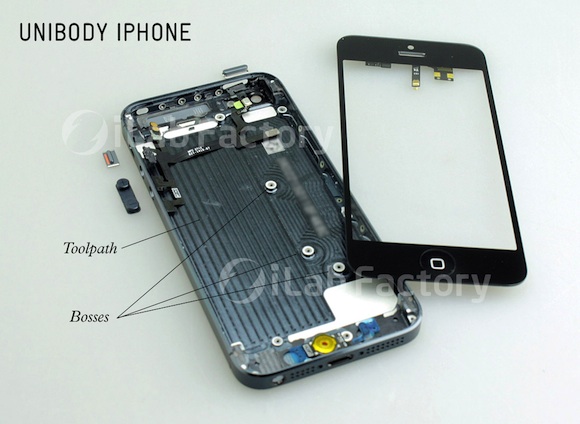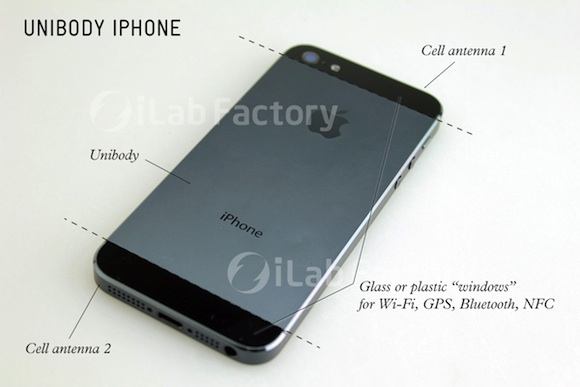In looking at the probable antenna design of the next-generation iPhone, Lehman notes how the antenna design evolved between the GSM iPhone 4 and the CDMA iPhone 4, the latter of which then carried over to the iPhone 4S. Following the "Antennagate" controversy with the original iPhone 4, Apple redesigned the antenna system in order to push the antennas to the top and bottom portions of the stainless steel band wrapping around the device, leaving the portions along the two long sides as structural and decorative pieces.
Lehman believes that Apple is using a similar principle for the next-generation iPhone, but has made the move to a "unibody" design in which the long side pieces and the large central section of the rear shell are machined from a single piece. The texture seen on the inside of the shell in leaked photos are in fact the tool marking showing how Apple machined the part out of a single block of metal.
The leaked design has three pieces of metal instead of four. It still has two U-shaped pieces at the top and bottom, but this time the two flat sides become one single piece of metal that also comprises the back of the device. That single piece of metal is the unibody backplate.
The same properties that unibody designs give to Apple’s laptops apply to this design as well: stronger, lighter, and thinner. You can see from this picture the tool path of the CNC machine that made the unibody backplate of this design. The tool path sort of looks like the lines that are made when a farmer plows a field. This started out as a single block of metal and the CNC carved that metal out until you have what you see here.

Lehman notes that even the bosses where screws for other components will attach are machined out of the single rear shell piece, increasing strength while reducing thickness and weight.
While Apple would certainly prefer to build the entire rear shell out of a single piece of metal, the realities of signal transmission mean that the company needs to use more transparent materials in locations where the antennas are. With the iPhone needing to send and receive Wi-Fi, cellular, GPS, Bluetooth, and perhaps NFC signals, Apple has pushed those hardware functions to the top and bottom of the device where they are the least shielded by other device components and the user's hand. Accommodating those functions has led Apple to adopt its new strategy of using a high-quality, thin metal shell wherever possible on the back of the device to increase strength and decrease size and weight while using glass or plastic windows for the antennas.

Lehman wraps up his post by addressing several other design aspects of the next-generation iPhone shell, including an examination of Apple's tinting of the metal on the black version of the device and placement of the rear camera with respect to the device design, as well as giving an overview of some of the other changes Apple has made for the forthcoming device.
Recent Mac and iOS Blog Stories
• Blizzard's Battle.net Hacked; Company Recommends All Users Change Their Passwords
• iOS 6 Beta Adds 'Wi-Fi Plus Cellular' Option to Increase Data Reliability
• Pixelmator 2.1 Adds Retina, iCloud and Mountain Lion Support
• Refurbished Current Generation iPads Available on Apple Online Store for $50 Off
• iFixit Launches Repair Guides for Retina MacBook Pro
DIGITAL JUICE
No comments:
Post a Comment
Thank's!